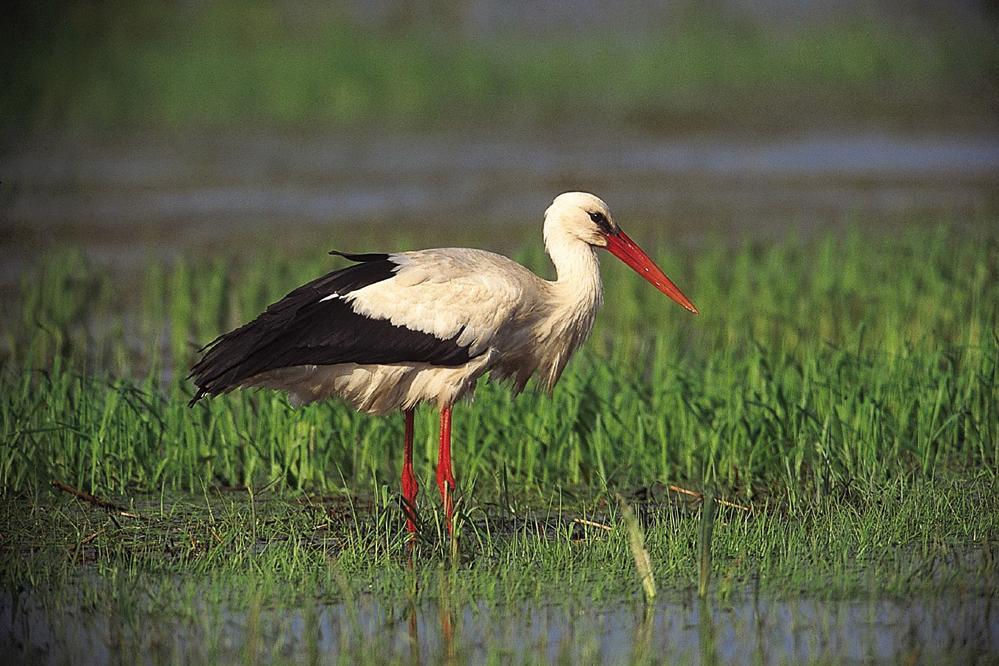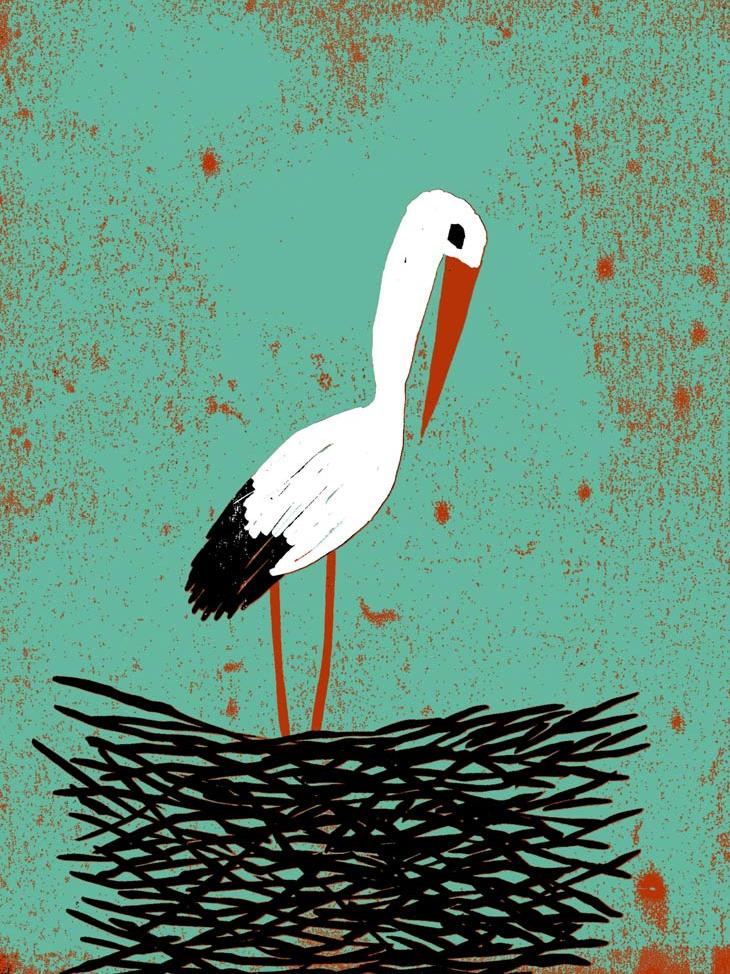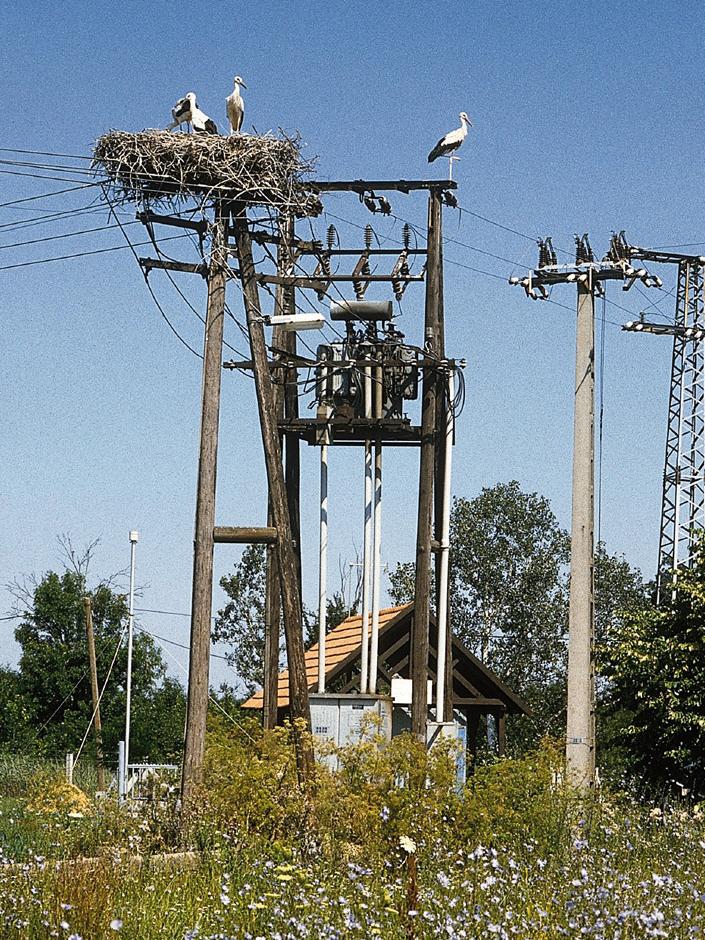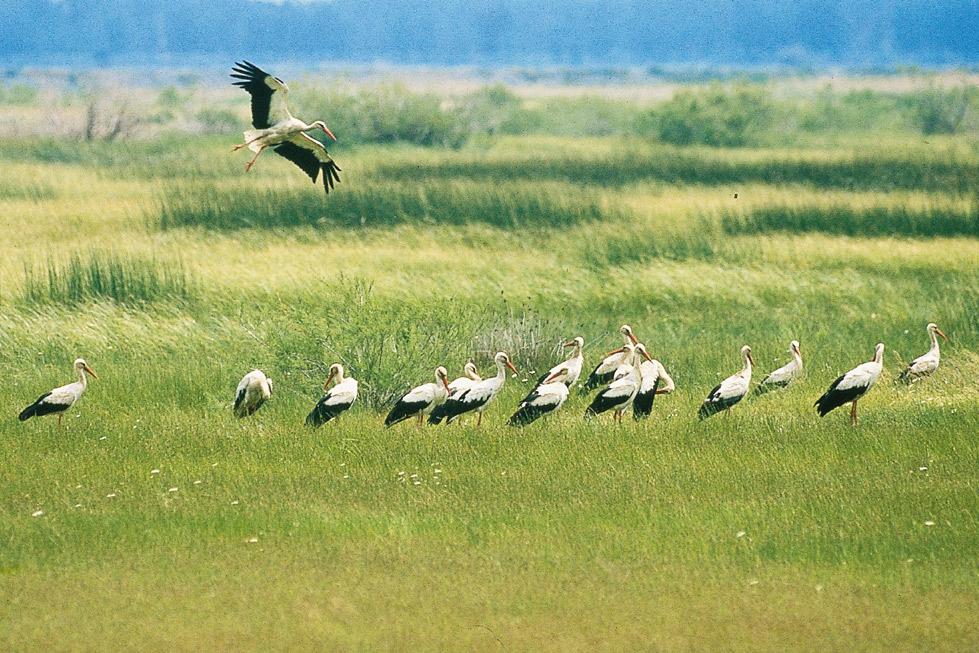The White Stork
The White Stork - avian pop star and wetland ambassador

The White Stork is so popular one could call it an avian pop star. It is known as the bringer of babies, luck and fertility all over Europe. It has been used in advertising campaigns for beer, nappies, condoms and various other goods, it can be seen on stamps and adorning coins. But where can this charismatic and beautiful bird still be seen in the wild? And did its status as a pop star help the species after all?
In short: Yes, it did help, but it didn´t prevent the vanishing of storks from areas where wetlands, wet meadows and extensive agriculture have disappeared. Storks and wetlands belong together and thus the White Stork is the European ambassador for the protection and restauration of wetlands, wet meadows and pastures.
The White Stork in European languages
English: White Stork
German/Austrian/Swiss: Weißstorch
Spanish: Cigueña blanca
Portuguese: Cegonha-branca
French: Cigogne blanche
Italian: Cicogna bianca
Dutch: Ooievaar
Danish: Hvid stork
Swedish: Vit stork
Norwegian: Stork
Finnish: Kattohaikara
Polish: Bocian biały
Estonian: Valge-toonekurg
Latvian: Baltais stārķis
Lithuanian: Baltasis gandras
Czech: Čáp bílý
Slovacian: Bocian biely
Hungarian: Fehér gólya
Romanian: Barză albă
Slovenian: Bela štorklja
Croatian: Bijela roda
Serbian: бели рода (Beli roda)
Macedonian: Бел штрк (Bel štrk)
Bulgarian: Белият щъркел (Belijat štărkel)
Greek: Λευκοπελαργός (Lefkopelargós)
Turkish: Leylek
Russian: Белый аист (Belij aist)
Of storks and man
From the wind battered cliffs of the Portuguese Cabo Sardo to the vast marshlands of Estonia and Latvia. The White Stork is a truly European bird and a typical migrant. Most storks breed in Europe during summer (extending to Marocco, Algeria and Tunisia) and spend the winter in Africa. There are two main flyways. One from western Europe via the Strait of Gibraltar on to West Africa and one from Eastern Europe via the Middle East to Eastern and Southern Africa. The birds of a small central area in Germany are known to choose either flyway.
The White Stork is one of the wild animals that has evolved the ability to live in close proximity to humans. As a so called synanthropic bird species it shows little shyness and builds its nests on churches, stables, houses, chimneys, electricity poles and even on art sculptures. This ability has saved the White Stork, or Ciconia ciconia as it is scientifically called, from the fate of its brother, Ciconia nigra, the black stork. European black storks are shy and build their nests exclusively in inaccessible cliffs or on trees in rather remote and undisturbed parts of the forest. So even if they forage in the same habitat and share the same food sources the black stork has become a rare sight in most of Europe.
Blue frogs, snakes and junk food – stork’s variable diet
As with their nesting grounds White Storks are not choosy when it comes to food. They are opportunistic and hunt according to the regional and seasonal availability of their food. Among their prey are earthworms, insects like big locusts and beetles, fish, frogs and snakes, but also mice, moles, voles and other small mammals up to the size of a juvenile hare. Studies have shown a strong relationship between food-availability and brood size. Being a big bird with an adult weight of approximately 3 to 4 kg, the amount of food needed to support a stork family is considerable. In southwestern Poland scientists have calculated that the stork parents have to find 180 kg of food in one breeding season, which corresponds 1.25 kg per day on average.1 The storks forage in agricultural fields, pastures, meadows and wetlands including rice fields, salinas, marshland, river banks and alluvial forest.
Kosicki, JZ et al., (2006) Food composition and energy demand of the White Stork Ciconia ciconia breeding population. Literature survey and preliminary results from Poland, in Tryjanowski P., Sparks T.H. & Jerzak L. (eds.) The White Stork in Poland: studies in biology, ecology and conservation Bogucki Wydawnictwo Naukowe, Poznań, p 169-183. https://www.researchgate.net/publication/237325391
Eavesdropping storks in Latvia
In the early breeding season White Storks in the marshlands of Latvia and Estonia depend on the abundance and carelessness of the moor frog (Rana arvensis): Male moor frogs have a sexual behaviour that could be described as „kamikaze speed dating“. Just for a few days in spring they paint themselves in a beautiful most obvious blue and start calling out loud to attract females. But they are not only attracting mates. Meanwhile a long-legged predator is straining ears. Thanks to the frogs mating calls the White Storks can easily locate their favourite spring food of an amphibian species that is rare in other parts of Europe.2
Igaune, K. et al. (2008) White storks Ciconia ciconia eavesdrop on mating calls of moor frogs Rana arvalis, Journal of Avian Biology. 39 (2): 229–32, doi: 10.1111/j.2008.0908-8857.04180.x
Ups and Downs

The White Stork suffered a steep decline in some parts of Europe during the last century mainly due to the intensification of agriculture and the loss of grassland, wetlands, wet meadows and other suitable habitats. But during the last 20 years the European population of the White Stork recovered. This is thanks to local conservation measures like artificial nesting platforms or wetland restoration. Particularly in Spain an increasing number of storks have utilized landfills and an invasive crayfish (Procambarus clarkii) in rice fields. As a result part of the population shortened their migration or stopped migrating, staying in Spain for the winter.34 Such man made food sources have the potential to change the natural behavior of the species, because migrating becomes a higher risk than staying.5
The number of breeding pairs has shown an 85 % increase in the west and a 31 % increase in the east between 1994 and 2004, with the world breeding population increasing to 233,000 pairs.6 In 2013 a study on the genetic structure of the European White Stork population showed a good genetic variation in spite of population declines and translocations.7
So the overall situation of the White Stork has improved thanks to the efforts of many conservationists all over Europe during the last decades - many of which played an active role in one of the European Stork Villages. But on the other hand we are still losing grasslands, wet meadows, moors, fens and other valuable stork habitat on a daily basis. So it doesn´t surprise that the situation for the storks on the local scale is quite bad in some areas. Take for example Poland. In comparison with other countries it is a stork paradise and used to claim being the European country with the most breeding pairs (up to 50.000). But nowadays Poland is losing storks. The national stork census of 2014 found that in one decade there were 15–20 % less storks throughout the country; the situation being especially bad in Southern and Western Poland with regional decline rates of up to 42 % in 10 years (Lower Silesia).8 Similar trends have been observed in Eastern Germany. The federal state Mecklenburg-Vorpommern lost 25 % of its breeding pairs between 2004 and 2014, most probably due to the agricultural trend of converting meadows and pastures into rape seed and corn fields.9
Rotics, S. et al. (2017) Wintering in Europe instead of Africa enhances juvenile survival in a long-distance migrant, Animal Behaviour 126 (2017), p. 79-88. https://dx.doi.org/10.1016/j.anbehav.2017.01.016
Gilbert, N.I. et al. (2016) Are white storks addicted to junk food? Impacts of landfill use on the movement and behaviour of resident white storks (Ciconia ciconia) from a partially migratory population. Mov. Ecol. 4, 7
Rotics, S. et al. (2017) Wintering in Europe instead of Africa enhances juvenile survival in a long-distance migrant, Animal Behaviour 126 (2017), p. 79-88. https://dx.doi.org/10.1016/j.anbehav.2017.01.016
Thomsen, K-M. (2013) White Stork populations across the world - Results of the 6th International White Stork Census 2004/2005. NABU publication. https://bergenhusen.nabu.de/weissstorch/17202.html
Shephard, JM et al. (2013) Is Population Structure in the European White Stork Determined by Flyway Permeability rather than Translocation History? Ecology and Evolution 3.15: 4881–4895. PMC. Web. 27 Mar. 2017.
Dangers: Power Lines, Poaching, Habitat Loss

Whereas adult White Storks have to fear few natural enemies, juveniles might be preyed on by big raptors. At the German European Stork Village Rühstädt White-tailed Eagles sometimes try to steal juvenile storks out of their nests. However, man-made factors like electrocution, poaching and habitat loss pose by far greater threats to Europe’s common stork.
Electrocution, the death of birds on insufficiently secured powerlines is still a big problem in many countries. Especially big birds can easily touch the high voltage lines with their long wings while perching on a pylon and thus suffer a deadly electric shock. The knowledge for the necessary insulation measures is readily available.10 Several electricity providers are engaged in securing pylons (many in cooperation with the ESVN), but more of this action is urgently needed, since there are still way too many pylons left unsecured, posing a deadly risk for storks and other large birds.
Annually millions of migrating birds get shot in the Mediterranean.11 People shoot and catch birds for various reasons. For food because of scarce resources like in parts of Africa, for a delicacy like in France or Italy, for tradition and collection like in Malta or just for the sake of hunting. Especially when it comes to migrating birds a lot of people haven´t evolved neither a feeling of responsibility for „their“ game, like many hunters have with non-migratory species, nor for the effects of their hunting, since the birds „come and go“ and it is difficult to realize the scope of the overall death toll to the species. Read Jonathan Franzen’s National Geographic article to get more insight in bird killing on the Eastern Flyway.
Learn more about EuroNatur’s anti-poaching campaign.
The storks migrating on the Eastern Flyway travel more dangerously than their relatives on the western route. Not only because they have a longer and more strenuous journey, but also due to poaching (e.g. in Lebanon, a migratory bottleneck, each year thousands of birds get killed by poachers among them many storks12). Regularly conservationists report poaching of storks from Turkey, Malta, Egypt and other countries. Most cases are kept in the dark, but e.g. in September 2016 a stork with a GPS-Tracker from Slovakian ornithologists was shot in the province Mersin in southern Turkey.13
Habitat loss – although not as dramatic in its direct effects as poaching and electrocution - might be the most severe danger to the White Stork in the long run. Moors, marshlands, wet meadows and pastures, once turned into arable land, roads, parking lots or buildings, can only be restored with considerable costs and over long periods of time if so at all. The White Stork likes to live close to humans, but we should remember that it is in fact a wild animal. If we neglect our „wild“ spaces and their natural inhabitants they soon might be gone. Like it has happened in the UK, Denmark and Albania14 – all being former home countries to breeding White Storks.
Haas, D., Nipkow, M. (2006) Caution: Electrocution - Suggested Practices for Bird Protection, NABU brochure, https://www.nabu.de/tiere-und-pflanzen/voegel/gefaehrdungen/stromtod/00664.html
Brochet A-L. et al. (2016) Preliminary assessment of the scope and scale of illegal killing and taking of birds in the Mediterranean, Bird Conservation International, Volume 26, Issue 1, pp. 1-28. DOI: https://doi.org/10.1017/S0959270915000416
Kozera (2014) White Storks Killings in Lebanon and the Effort to Stop It: The Role of Social Media in Spreading and Counteracting the Phenomenon, Studia z Etyki i Edukacji Globalnej nr 1/2014, p. 80-104; DOI: 10.5604/2354029X.
Albania recently has seen the reestablishment of breeding white storks: https://www.researchgate.net/publication/259812739_Recent_breeding_records_of_White_Stork_Ciconia_ciconia_from_Vurgu_Field_Southern_Albania
Bring the storks back home!

Several European regions show the way how conservation and reintroduction efforts can bring the storks back. Thanks to decades of conservation work the French Alsace-region today again counts about 800 breeding pairs, after the population was reduced to just nine breeding pairs in 1974.15 Similar success can be reported from Rhineland-Palatinate, a federal state in southwestern Germany. After the breeding population became extinct in the 1950s, a successful reintroduction project from 1996 to 2013 led to a sustainable White Stork population counting now more than 150 breeding pairs.16 Other successful White Stork projects have been implemented in Italy, Switzerland and Sweden among others. Together with the European Stork Villages these examples show that it is very worthwhile to invest a lot of energy and spirit in the conservation of one of the most beautiful and iconic bird species in Europe. The White Stork and a diverse and healthy rural European landscape are two sides of the same coin. Let´s keep them alive!
Dorner I & Tietze DT (2015): Die Wiederansiedlung des Weißstorchs Ciconia ciconia in Rheinland-Pfalz. [Reintroduction of the White Stork Ciconia ciconia in Rheinland-Pfalz.] Vogelwarte 53: 99–119.
 Report sighting
Report sighting
Have you seen a white stork or another interesting species of animal, plant or fungus? Make your observation count for nature conservation and share it with other nature lovers! It’s free and it’s fun!





